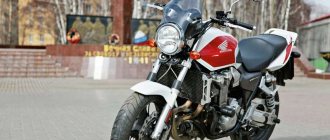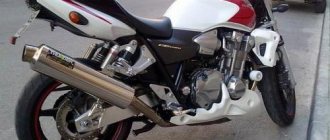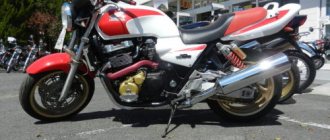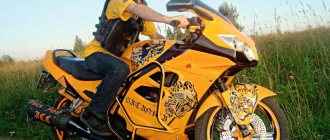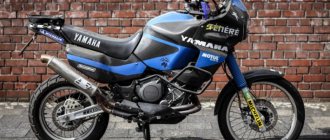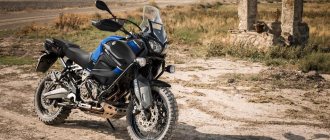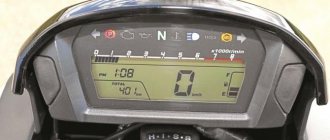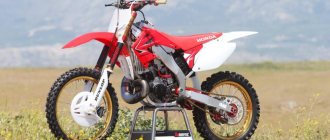| Honda CB1300 (1998-2002) | Honda CB1300 (2003-2013) | Honda CB1300 (2014-2019) | Honda CB1300S Boldor (2005-2013) |
| Honda CB1300S Boldor (2014-2019) | Honda CB1300 Super Four SP (2019+) | Honda CB1300 Super Bold'or SP (2019+) | Honda CB1300 Super Four (2021+) |
| Honda CB1300 Super Bold'or (2021+) |
Model of the classic motorcycle Honda CB 1300
was first presented in 1997 at the Tokyo Motor Show as a successor to the Honda CB 1000. Official production of the model began in 1998, the main sales market is Japan. Since 2003, the model was updated to the 2nd generation and was exported to Europe, Asia, Oceania and South America. It is noteworthy that the Honda CB1300 was never delivered to North America.
The model may be sold under the following names: Honda CB1300SF
,
Honda CB1300 Super Four
.
The basis of the Honda CB1300SF was a carburetor, in-line 4-cylinder liquid-cooled engine (SC38) with a volume of 1284 cc. see, producing 100 hp. power and almost 120 Nm of torque. The engine is identical to the one installed on the Honda X4 dragster. Subsequently, from 2003, the motorcycle received a new injection engine (SC54E) and increased maximum power to 115 hp.
Among the features of the Honda CB 1300 model, we should highlight a steel duplex frame, classic suspension in the form of a simple telescopic fork at the front and dual shock absorbers at the rear, powerful 6-piston front disc brakes (since 2001 - 4-piston), the availability of versions with ABS (since 2005 ), 5-speed gearbox (6-speed - since 2014), 21 liter fuel tank and 252-284 kg curb weight (depending on generation and version).
Main generations of Honda CB1300SF (Super Four):
- 1998-2002 - first generation
.
Models from these years are only available in the Japanese domestic market and have similar features to the Honda CB1000. Frame number: SC40
-XXXXXXX. They are distinguished by a power of 100 hp, a carburetor engine, 6-piston front calipers (since 2001 - 4-piston), a fork with a 45 mm diameter of feathers, a progressive rear suspension (Pro-Link), wide tires (130 and 190 mm) and a curb weight of 273 kg. - 2003+ - second generation
.
Models of these years are officially sold not only in Japan, but also in Europe, Asia, Oceania and some countries in South America. Visually they are distinguished by their sharp tail, 5-spoke wheels and engine appearance. Frame number: SC54
-XXXXXXX. The model receives an injection engine (maximum power 115 hp), a fork with a 43 mm diameter of stays, a new rear suspension without progression (Pro-Link), 4-piston calipers, thinner tires of 120 and 180 mm, versions with ABS, weight reduction to 252 kg and new modifications (2005: Super Bold'Or; 2009: Super Touring).
Main versions of Honda CB1300:
- Honda CB1300SF (Super Four)
- regular classic version. - Honda CB1300S / SB (Super Bold'Or)
- version with semi-fairing, rectangular headlight and glove compartments on the left and right (about 1 l). Available since 2005. - Honda CB1300ST (Super Touring)
- touring version. It is equipped with 29 liter side cases, combined brakes with ABS, a different exhaust system (which reduced the maximum power to 100 hp and torque to 113 Nm), a more powerful generator and a curb weight of 284 kg. Available from 2010 to 2014.
The company will temporarily suspend production of the CB1300 in 2022, resuming it in 2022 for the Japanese market.
At the end of October 2022, Honda introduced new modifications of the model - Honda CB1300 Super Four SP
and
Honda CB1300 Super Bold'or SP
. The modifications feature more expensive equipment, in particular Öhlins suspensions and Brembo monoblock front brakes.
On December 21, 2022, the company releases the new generation CB1300. The main changes affected the electronic equipment of the motorcycle - in particular, an electronic throttle (Ride-by-Wire), cruise control, Ride Mode, HSTC (Honda Selectable Torque Control) and a quickshifter were added as an option. In addition, the engine settings, weight and dimensions of the motorcycle and the rear brake changed (disc diameter was reduced from 276 to 256 mm).
Honda CB1300: electronic equipment
- ABS - since 2003
- LED headlight - since 2014
- Slipper clutch and clutch assist (Assist & Slipper clutch) - from 2022 (from October 2017)
- Heated grips - from 2022 (from October 2017)
- Electronic Throttle (Ride-by-Wire) - from 2021
- 3 Riding Mode - from 2022
- HSTC (Honda Selectable Torque Control) - from 2022
- Cruise control - from 2022
- Quick-shifter (optional) - from 2022
The main competitors of the Honda CB 1300 in the class:
- Kawasaki ZRX 1200
- Suzuki GSF 1200 Bandit / 1250 Bandit
- Suzuki GSX 1200 Inazuma / Suzuki GSX 1400
- Yamaha XJR 1300
Brief history of the model
- 1998 - start of production and sales of the Honda CB1300 Super Four model. First generation
.
Model:
'onda CB1300SF (Super Four) (Japan).
Frame/Engine Number:
SC40-100XXXX / SC38-150XXXX-1549999.
Model code:
CB1300Fw.
- 1999 - The model receives front fork preload adjustment and a center stand.
Model:
Honda CB1300SF (Super Four) (Japan).
Frame/Engine Number:
SC40-105XXXX / SC38-155XXXX.
Model code:
CB1300Fx.
- 2000 - This year's models feature gold calipers and a silver radiator finish.
Model:
Honda CB1300SF (Super Four) (Japan).
Frame/Engine Number:
SC40-106XXXX / SC38-156XXXX.
Model code:
CB1300Fy.
- 2001 - the model receives fuel consumption optimization, reducing gasoline consumption by 8% (21.6 km/l → 23.5 km/l at a speed of 60 km/h). By changing the metal thickness of the exhaust system, wheel rims, using lighter chassis materials and using new 4-piston calipers from the Honda VTR1000F, the overall weight of the motorcycle was reduced by 5 kg.
Model:
Honda CB1300SF (Super Four) (Japan).
Frame/Engine Number:
SC40-107XXXX / SC38-157XXXX.
Model code:
CB1300F1.
- 2002 - no significant changes.
Model:
Honda CB1300SF (Super Four) (Japan).
Frame/Engine Number:
SC40-108XXXX / SC38-158XXXX.
Model code:
CB1300F2.
- 2003 - second generation
. In addition to the Japanese market, the model is officially available in Europe and Oceania. The model receives a new injection engine with a thinner cylinder block and a new ignition system. Maximum power rises to 115 hp, torque drops to almost 117 Nm and is available 1000 rpm later. New visual features with sharp tail and 5-spoke wheels. New exhaust system with one muffler. The tire size has been reduced to 120 mm at the front and 180 mm at the rear. New rear suspension mechanism without progression arms (Pro-Link). New frame (lightened by 7 kg and reduced wheelbase by 30 mm). Immobilizer HISS. New dashboard. Increased luggage compartment (up to 12 l). Curb weight has dropped to 252 kg.
Model:
Honda CB1300SF (Super Four) (Japan). Frame number: SC54-100XXXX. Model code: CB1300F3/F13.
Model:
Honda CB1300SF (Super Four) (Europe).
Frame number:
JH2SC54A*3M3MXXXXXX, JH2SC54B*3M3MXXXXXX.
Model code:
CB1300F3/F13.
Model:
Honda CB1300SF (Super Four) (Oceania).
Frame number:
JH2SC54U*3M3MXXXXXX.
Model code:
CB1300F3/F13.
- 2004 - no significant changes.
Model:
Honda CB1300SF (Super Four) (Japan).
Frame number:
SC54-110XXXX.
Model code:
CB1300F4/F14.
- 2005 - appearance of the Super Bold'Or modification and versions with ABS. Minor changes have been made to the injection and ignition system to improve engine response at low speeds. This year's models feature gold-colored wheels.
Model:
Honda CB1300SF (Super Four), Honda CB1300 (ABS) Super Four, Honda CB1300S Super Bol d'Or (Asia, Europe, Oceania).
Frame number:
JH2SC54A*5M5MXXXXXX, JH2SC54B*5M5MXXXXXX, JH2SC54C*5M5MXXXXXX, JH2SC54D*5M5MXXXXXX, JH2SC54E*5M5MXXXXXX, JH2SC54F*5M5MXXXXXX (Europe);
JH2SC54U*5M5MXXXXXX (Oceania); JH2SC549*5M5MXXXXXX (Korea); SC54-120XXXX (Japan). Model code:
CB13005 / CB1300A5 / CB1300S5 / CB1300SA5.
- 2006 - no significant changes.
Model:
Honda CB1300SF (Super Four), Honda CB1300 (ABS) Super Four, Honda CB1300S Super Bol d'Or, Honda CB1300 (ABS) Super Bol d'Or (Asia, Oceania).
Frame number:
JH2SC54U*6M6MXXXXXX (Oceania);
JH2SC54K*6M6MXXXXXX (Korea); SC54-130XXXX (Japan). Model code:
CB13006 / CB1300A6 / CB1300S6 / CB1300SA6.
- 2007 - no significant changes.
Model:
Honda CB1300SF (Super Four), Honda CB1300 (ABS) Super Four, Honda CB1300S Super Bol d'Or, Honda CB1300 (ABS) Super Bol d'Or (Asia, Europe, Oceania, South America).
Frame number:
JH2SC54A*7M7MXXXXXX, JH2SC54B*7M7MXXXXXX, JH2SC54C*7M7MXXXXXX, JH2SC54D*7M7MXXXXXX, JH2SC54E*7M7MXXXXXX, JH2SC54F*7M7MXXXXXX (Europe);
JH2SC54U*7M7MXXXXXX (Oceania); JH2SC549*7M7MXXXXXX (Brazil); SC54-140XXXX (Japan). Model code:
CB13007 / CB1300A7 / CB1300S7 / CB1300SA7.
- 2007 - no significant changes.
Model:
Honda CB1300SF (Super Four), Honda CB1300 (ABS) Super Four, Honda CB1300S Super Bol d'Or, Honda CB1300 (ABS) Super Bol d'Or (Asia, Europe, Oceania, South America).
Frame number:
JH2SC54A*7M7MXXXXXX, JH2SC54B*7M7MXXXXXX, JH2SC54C*7M7MXXXXXX, JH2SC54D*7M7MXXXXXX, JH2SC54E*7M7MXXXXXX, JH2SC54F*7M7MXXXXXX (Europe);
JH2SC54U*7M7MXXXXXX (Oceania); JH2SC549*7M7MXXXXXX (Brazil); SC54-140XXXX (Japan). Model code:
CB13007 / CB1300A7 / CB1300S7 / CB1300SA7.
- 2008 - the model receives a new catalyst. This year's models feature a matte gray metallic engine color.
Model:
Honda CB1300SF (Super Four), Honda CB1300 (ABS) Super Four, Honda CB1300S Super Bol d'Or, Honda CB1300 (ABS) Super Bol d'Or (Asia, Europe, Oceania).
Frame number:
JH2SC54A*8K8KXXXXXX, JH2SC54A*8M8MXXXXXX, JH2SC54B*8M8MXXXXXX, JH2SC54B*8K8KXXXXXX, JH2SC54C*8M8MXXXXXX, JH2SC54C*8K8KXXXXXX , JH2SC54D*8M8MXXXXXX, JH2SC54 D*8K8KXXXXXX, JH2SC54E*8M8MXXXXXX, JH2SC54E*8K8KXXXXXX, JH2SC54F*8M8MXXXXXX, JH2SC54F*8K8KXXXXXX (Europe);
JJH2SC54U*8M8MXXXXXX, JH2SC54U*8K8KXXXXXX (Oceania); JH2SC549*8M8MXXXXXX, JH2SC549*8K8KXXXXXX (Singapore); JH2SC54K*8M8MXXXXXX, JH2SC54K*8K8KXXXXXX (Korea); SC54-150XXXX (Japan). Model code:
CB13008 / CB1300A8 / CB1300S8 / CB1300SA8.
- 2009 - no significant changes.
Model:
Honda CB1300SF (Super Four), Honda CB1300 (ABS) Super Four, Honda CB1300S Super Bol d'Or, Honda CB1300 (ABS) Super Bol d'Or (Asia, Europe, Oceania).
Frame number:
JH2SC54A*9K9KXXXXXX, JH2SC54C*9K9KXXXXXX, JH2SC54D*9K9KXXXXXX, JH2SC54E*9K9KXXXXXX, JH2SC54F*9K9KXXXXXX (Europe);
JH2SC54U*9K9KXXXXXX (Oceania); JH2SC549*9K9KXXXXXX (Singapore); JH2SC54K*9K9KXXXXXX (Korea); SC54-160XXXX (Japan). Model code:
CB13009 / CB1300A9 / CB1300S9 / CB1300SA9.
- 2010 - appearance of the Super Touring modification. The capacity of the generator has been increased, the seat height has been reduced to 780 mm, and the rear brake light has become LED.
Model:
Honda CB1300SF (Super Four), Honda CB1300 (ABS) Super Four, Honda CB1300S Super Bol d'Or, Honda CB1300 (ABS) Super Bol d'Or, Honda CB1300 (ABS) Super Touring (Asia, Europe, Oceania).
Frame number:
SC54-170XXXX (Japan).
Model code:
CB1300A / CB1300AA / CB1300SA / CB1300SAA, CB1300TAA.
- 2011 - no significant changes.
Model:
Honda CB1300SF (Super Four), Honda CB1300 (ABS) Super Four, Honda CB1300S Super Bol d'Or, Honda CB1300 (ABS) Super Bol d'Or, Honda CB1300 (ABS) Super Touring (Asia, Europe, Oceania).
Frame number:
SC54-180XXXX (Japan).
Model code:
CB1300В / CB1300АВ / CB1300СВ / CB1300SAВ, CB1300TAВ.
- 2012 - no significant changes.
Model:
Honda CB1300SF (Super Four), Honda CB1300 (ABS) Super Four, Honda CB1300S Super Bol d'Or, Honda CB1300 (ABS) Super Bol d'Or, Honda CB1300 (ABS) Super Touring (Asia, Europe, Oceania).
Frame number:
SC54-190XXXX (Japan).
Model code:
CB1300C / CB1300AC / CB1300SC / CB1300SAC, CB1300TAC.
- 2013 - no significant changes.
Model:
Honda CB1300SF (Super Four), Honda CB1300 (ABS) Super Four, Honda CB1300S Super Bol d'Or, Honda CB1300 (ABS) Super Bol d'Or, Honda CB1300 (ABS) Super Touring (Asia, Europe, Oceania).
Frame number:
SC54-200XXXX (Japan).
Model code:
CB1300D / CB1300AD / CB1300SD / CB1300SAD, CB1300TAD.
- 2014 - Super Touring no longer offered. The model receives a 6-speed gearbox, changed injection system settings (fuel efficiency has increased from 25.5 km/l to 26.8 km/l at a speed of 60 km/h), new 10-spoke wheels. The Super Bold'Or version receives changes to the half-fairing design and LED headlights.
Model:
Honda CB1300SF (Super Four), Honda CB1300 (ABS) Super Four, Honda CB1300S Super Bol d'Or, Honda CB1300 (ABS) Super Bol d'Or (Asia, Europe, Oceania).
Frame number:
SC54-200XXXX (Japan).
Model code:
CB1300E / CB1300AE / CB1300SE / CB1300SAE.
- 2015 - no significant changes.
Model:
Honda CB1300SF (Super Four) + ABS;
Honda CB1300S Super Bol d'Or + ABS (Asia, Europe, Oceania). Model code:
CB1300ADF; CB1300SADF
- 2016 - no significant changes.
Model:
Honda CB1300SF (Super Four) + ABS;
Honda CB1300S Super Bol d'Or + ABS (Asia, Europe, Oceania). Model code:
CB1300ADG; CB1300SADG
- 2017 - model not produced.
- 2018 - the maximum power of the domestic Japanese version increases: 101 → 110 hp. The model is only available on the Japanese market.
Model:
Honda CB1300SF (Super Four) + ABS;
Honda CB1300S Super Bol d'Or + ABS (Japan). Model code:
CB1300ADJ; CB1300SADJ
- 2019 - appearance of new modifications of SP.
Model:
Honda CB1300SF (Super Four) + ABS;
Honda CB1300S Super Bol d'Or + ABS; Honda CB1300 Super Four SP + Super Bold'or SP (Japan). Model code:
CB1300ADK; CB1300SADK; CB1300SPK + CB1300SSPK
- 2020 - only SP versions are produced.
Model:
Honda CB1300 Super Four SP / Super Bold'or SP (Japan).
Model code:
CB1300SPL / CB1300SSPL.
- 2021 - restyling of the model.
Model:
Honda CB1300 Super Four + SP; Honda CB1300 Super Bold'or + SP (Japan).
- 2022 - no significant changes.
Model:
Honda CB1300 Super Four + SP; Honda CB1300 Super Bold'or + SP (Japan).
Bike features
Here are the main features of the Honda CB 1300:
- spacious fuel tank;
- availability of versions with ABS;
- powerful front brakes.
This motorcycle is one of the few modern representatives of the class that optimally corresponds to a classic bike in the full sense. This is neither an ultra-modern option with perfectly streamlined shapes, nor a retro classic, but something completely universal.
Reviews
Reviews of Honda CB1300SF:
Expand Collapse
I have a 2004 CB1300SF-2. Completely satisfied. The motor is universal, it behaves perfectly in the city and on the highway. Fuel consumption is from 4 liters to 7 liters, 92 gasoline and depends only on the driving mode. no oil consumption. Doesn't eat rubber, doesn't eat pads. Comfortable speed is 100-160 km/h, grip is possible up to 240 km/h, but not for long))
There are no problems, partly because the motor is almost new. In Japan there is a sea of tuning and fetish for it. You can make it both a sport and a tourer and simply dress it up as your heart desires. There is only one problem - its price. For less than 7000 there, you can’t get a good one now. And almost new 2004-07 with a mileage of 4000-10000 km from 8500 ye there.
I have both motorcycles! SV 1000 Motorcycle for tall people, moderate weight. You can hold it when you fall onto your side. (In the name of saving the tank, when falling at a very low speed, I held the motorcycle but broke a rib).
1300 first. Motor carburetor. Price from 150,000. The device is NOT suitable for a person over 189 in height. Drawbar traction, excellent motor. 1300 since 2003. Price from 220,000 rub. New engine, injector, Modern design, PARAVOZ traction (Like the previous 1300). Just as tall!!!!!!!!!!!!!!!! those. for people from 186. Compared to SV 1000 it is heavier. The SV 1300 is heavier, which is why extreme conditions on a curved road (Asphalt with parallel waves, emergency maneuver) require the height and weight of the pilot to cope. When braking, there is a feeling of a HAMMER flying into an anvil (the vehicle ahead). When moving quietly, it is obedient and understandable, like a native SV1000. On the new 1300, the very wide radiator per liter is much more compact. The rest is without noticeable changes.
The SV1300, which with an injector is LIGHTER than the SV1000, and definitely steers better (apparently a stiffer chassis), the brakes are also okay, it’s not the weight, but the much greater thrust of the engine, the speed on it is felt only at the turn of 170-180 km/h, that’s why the braking is late (personal experience, by the way, for a long time I couldn’t understand why the braking distance had increased, then it dawned on me that everything was OK with the brakes, it was me who started driving faster), tall, yes, it’s especially “uneasy” for the passenger to climb onto the seat, The engine is simply a beast, with a sharp opening of the gas in 1st and 2nd gears, intense slipping of the rear wheel is possible (especially on unheated tires), you can also get cocky, but it’s a pity for the suspension, this of course does not mean that the SV 1000 is a bad motorcycle, quite the contrary, it’s great , a comfortable, quite playful motorcycle, with almost unlimited possibilities for tuning, was supplied all over the world (you can order cheaper parts from the states), today it is probably the best offer in terms of price/quality ratio.
Hello. My motor is CB1300, I have ridden it for one season so far, there were other motors before it, so I had no problems with control. The main advantage of this motorcycle for me personally is that it holds the road very confidently. I don’t install a windshield because of ethical reasons, I stick to the classic look of the motorcycle. I don't go over 140. It accelerates quite quickly. In general, it is well balanced and therefore very maneuverable. The only downside is that it consumes 10 liters of fuel in the city.
Due to the accident, I was temporarily left without my Bandit (it will take at least 5-7 weeks to collect information, communicate with the insurance company and, directly, repairs), but, as they say, the world is not without good people and now I drive a 1999 Superfur. , freshly imported from Japan with 35,000 km on the odometer, already perfumed.
So, impressions after 1,500 km:
1. Appearance.
Honda is longer and wider. Two exhaust pipes, protruding shock absorbers with springs, a large engine. However, Bandit looks more modern.
2. Landing
On the Honda, the seat is lower and, it would seem, should be more comfortable, but no. Due to the fact that the footpegs are located at approximately the same level as on the Bandit, the legs have to be bent more during movement, which after a long ride leads to unpleasant sensations. In addition, the seat itself is designed in such a way that you constantly slide towards the tank. The steering wheel is high and wide – it’s more comfortable on the highway; in the city you have to be careful between the rows. The mirrors are comfortable, you can only dream of such mirrors on Bandit. The footrest is located somewhere far behind, so it is not very convenient to pull it out.
3. Suspension.
On a Honda it is very soft. Where the Bandit practically jumps at speed (bridges on New Riga), the Honda floats without any unpleasant sensations for the driver. But there is also the other side of the coin - periodically in the pits the front suspension breaks (which happened to the bandit only once in a very serious pit).
4. Controllability.
At first it seemed that the Honda handled harder than the Bandit and, at first, there was no particular desire to go into a low angle, but, having gotten used to it, I laid it a couple of times at the speed with which I usually took these turns on the Bandit, and did not get any unpleasant sensations.
5. Engine and gearbox.
The Bandit spins up faster, the gears are switched harshly, starting from a standstill, you need to make a serious effort to switch from 1st to 2nd. Sometimes it happens that you put it in neutral. There are no such problems on the Honda - everything is soft and clear. In all the time I’ve been driving the Bandit, I’ve never unscrewed it to the cut-off point - there’s always enough power and gear; on a Honda, during dynamic acceleration, the cut-off constantly occurs. Gasoline consumption is approximately the same - 7-8 liters per hundred.
6. At speed.
Oddly enough, the Honda was able to accelerate to greater speed. The speedometer on it is marked up to 180 km/h. I removed the limiter and, using the navigator, accelerated it to the cutoff in fifth gear (i.e., to the maximum). The result according to the navigator is 212 km/h, which would be ok according to the speedometer. 235 km/h. On the Bandit, I pushed the speedometer to the maximum of 225 km/h (but here I must give the Bandit its due - it was far from the cutoff, and the road conditions did not allow it to accelerate further).
7. Brakes.
I admit, I didn’t brake sharply on the Honda, due to the fact that it does not have ABS installed, but, in principle, it brakes not much worse than the Bandit and responds better to the rear brake.
Conclusions:
The Honda is a powerful and soft motorcycle, you can ride in traffic jams without any problems, you can, if you wish, have a blast (another question is that this desire rarely appears), it behaves well on the highway at high speeds.
The bandit is evil. Stiff suspension, hard gear shifting, very fast start from traffic lights and at the same time uncomfortable sensations at speeds above 200 km/h.
Engine
The Honda SB 1300 has an in-line engine, which is four-stroke and four-cylinder. Its effective capacity is 1284 cm³. This unit is cooled by liquid. Peak performance is as follows: torque will be 116.7 Nm, while power will be 115 hp. The speed at its peak is 220 km/h. Acceleration to hundreds is achieved in 3.5 seconds, but you should be careful when accelerating on this model.
Dimensions and weight
The model reaches 2220 mm in length, 790 mm in width, and 1120 mm in height. The seat height here is 780 mm, while the wheelbase is 1515 mm. Without fuel, the bike weighs 224 kg, and its tank capacity is 21 liters. Gasoline consumption greatly depends on driving style, but the motorcycle stubbornly refuses to consume less than 7 liters per hundred kilometers.
Chassis and brakes
The frame of the machine is made of steel, and the type is duplex. The wheels on this model are alloy, and the steering wheel is typical for the class. In general, the exterior looks impressive, no less catchy than many motorcycles with a much more modern look.
The rear suspension is pendulum and equipped with two shock absorbers. This is a completely typical solution for such a motorcycle. At the front there is a 43 mm telescopic fork. The rear brake is represented by a single-piston caliper and a 276 mm disc, and the front has four-piston calipers and a pair of 310 mm discs. Such a braking system should probably be sufficient at high speeds.
